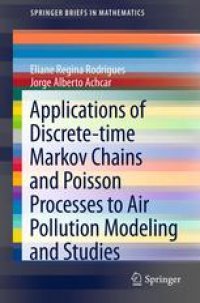
Ebook: Applications of Discrete-time Markov Chains and Poisson Processes to Air Pollution Modeling and Studies
- Tags: Probability Theory and Stochastic Processes, Environmental Monitoring/Analysis, Atmospheric Protection/Air Quality Control/Air Pollution
- Series: SpringerBriefs in Mathematics
- Year: 2013
- Publisher: Springer-Verlag New York
- Edition: 1
- Language: English
- pdf
In this brief we consider some stochastic models that may be used to study problems related to environmental matters, in particular, air pollution. The impact of exposure to air pollutants on people's health is a very clear and well documented subject. Therefore, it is very important to obtain ways to predict or explain the behaviour of pollutants in general. Depending on the type of question that one is interested in answering, there are several of ways studying that problem. Among them we may quote, analysis of the time series of the pollutants' measurements, analysis of the information obtained directly from the data, for instance, daily, weekly or monthly averages and standard deviations. Another way to study the behaviour of pollutants in general is through mathematical models. In the mathematical framework we may have for instance deterministic or stochastic models. The type of models that we are going to consider in this brief are the stochastic ones.
?In this brief we consider some stochastic models that may be used to study problems related to environmental matters, in particular, air pollution. The impact of exposure to air pollutants on people's health is a very clear and well documented subject. Therefore, it is very important to obtain ways to predict or explain the behaviour of pollutants in general. Depending on the type of question that one is interested in answering, there are several of ways studying that problem. Among them we may quote, analysis of the time series of the pollutants' measurements, analysis of the information obtained directly from the data, for instance, daily, weekly or monthly averages and standard deviations. Another way to study the behaviour of pollutants in general is through mathematical models. In the mathematical framework we may have for instance deterministic or stochastic models. The type of models that we are going to consider in this brief are the stochastic ones.?
?In this brief we consider some stochastic models that may be used to study problems related to environmental matters, in particular, air pollution. The impact of exposure to air pollutants on people's health is a very clear and well documented subject. Therefore, it is very important to obtain ways to predict or explain the behaviour of pollutants in general. Depending on the type of question that one is interested in answering, there are several of ways studying that problem. Among them we may quote, analysis of the time series of the pollutants' measurements, analysis of the information obtained directly from the data, for instance, daily, weekly or monthly averages and standard deviations. Another way to study the behaviour of pollutants in general is through mathematical models. In the mathematical framework we may have for instance deterministic or stochastic models. The type of models that we are going to consider in this brief are the stochastic ones.?
Content:
Front Matter....Pages i-x
Introduction....Pages 1-10
Markov Chain Models....Pages 11-23
Poisson Models and Their Application to Ozone Data....Pages 25-64
Modeling the Time Between Ozone Exceedances....Pages 65-78
Some Counting Processes and Ozone Air Pollution....Pages 79-89
Comments....Pages 91-92
Back Matter....Pages 93-107
?In this brief we consider some stochastic models that may be used to study problems related to environmental matters, in particular, air pollution. The impact of exposure to air pollutants on people's health is a very clear and well documented subject. Therefore, it is very important to obtain ways to predict or explain the behaviour of pollutants in general. Depending on the type of question that one is interested in answering, there are several of ways studying that problem. Among them we may quote, analysis of the time series of the pollutants' measurements, analysis of the information obtained directly from the data, for instance, daily, weekly or monthly averages and standard deviations. Another way to study the behaviour of pollutants in general is through mathematical models. In the mathematical framework we may have for instance deterministic or stochastic models. The type of models that we are going to consider in this brief are the stochastic ones.?
Content:
Front Matter....Pages i-x
Introduction....Pages 1-10
Markov Chain Models....Pages 11-23
Poisson Models and Their Application to Ozone Data....Pages 25-64
Modeling the Time Between Ozone Exceedances....Pages 65-78
Some Counting Processes and Ozone Air Pollution....Pages 79-89
Comments....Pages 91-92
Back Matter....Pages 93-107
....